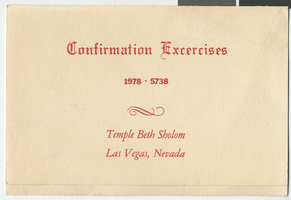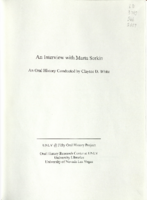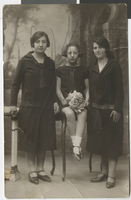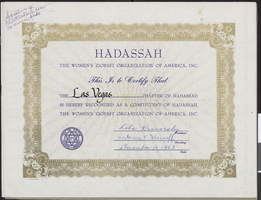Search the Special Collections and Archives Portal
Search Results
Lyn Robinson oral history interview
Identifier
Abstract
Oral history interview with Lyn Robinson conducted by Barbara Tabach on September 18, 2014 for the Southern Nevada Jewish Heritage Project. Robinson talks about her participation with the Sperling Kronberg Mack Holocaust Resource Center as an official photographer of survivors for the Center.
Archival Collection

Lori Chenin-Frankl photographs and ephemera, 1964-1978
Date
Archival Collection
Description
Photographs, report card, and confirmation programs from Lori Chenin-Frankl.
Mixed Content

Transcript of interview with Marta Sorkin by Claytee White, March 2, 2009
Date
Archival Collection
Description
In this interview, conducted for the 50th anniversary of UNLV, Marta Sorkin discusses her family and her experience moving to California, and then to Las Vegas. Sorkin worked at the James R. Dickinson Library at UNLV and later in Lied Library, helping to implement and update various databases, and create displays on current topics. She briefly discusses her involvement with Hillel and the Jewish Federation of Las Vegas.
Marta Sorkin begins by reminiscing about her childhood in Far Rockaway Long Island, New York. She details the life her parents lived, which set an example for Marta and her two siblings. Through hard work, advanced education, and involvement in causes that were important to them, they created the template by which Marta lives her life. Marta describes her early work history, which included modeling, sales, library work, and working part time in her father's dry-cleaning plant. She and her daughter were living with her parents for a time in California, and they visited Las Vegas on weekends. It was during one of those visits that Marta met her second husband-to-be. They eventually married and decided to settle in Las Vegas. In Las Vegas, Marta enrolled at UNLV, became involved with the Preservation Association of Clark County, and volunteered at the Jewish Federation of Las Vegas. In addition, she completed her BA and MA degrees at UNLV and started working at the university's library. She details her work there, including creating display cases, working in the reference section, doing research for students and faculty, and compiling interviews. Marta also describes the fundraisers she spearheaded to help raise money for the various societies she was involved with: non-events, pancake breakfasts, dinners, and dance and band performances. In her closing comments she mentions an interview she did for Ralph Roske's class and expresses her appreciation for the career she's had at UNLV.
Text

Jack Weinstein and Polly Weinstein interview, April 12, 2018: transcript
Date
Archival Collection
Description
Tower of Jewels is one of those iconic Las Vegas businesses that continues to thrive. At the time of this interview, Jack Weinstein is in his nineties and “retired.” With him is his daughter Polly Weinstein, who in addition to being involved in the business management has her own custom designed jewelry line, aptly named The Jeweler’s Daughter. As the youngest of six children born to Jewish Russian immigrants Joseph and Pauline (Polly is named for her grandmother), Jack was raised in a dangerous neighborhood of Detroit, Michigan. His youthful enterprise included collaborating and then splitting up with his brothers in a jewelry business, before eventually moving west to Los Angles in the early 1960s. On his own, Jack became a wholesale salesperson representing lines of watches to other businesses. Included in his list of clients was Al Sanford’s Tower of Jewels in Las Vegas. The two became friends and Al suggested setting up a partnership between Al’s son and Jack in 1964. Eventually
Text

Transcript of interview with Ike Lawrence Epstein by Barbara Tabach, August 24, 2017 and February 2, 2018
Date
Archival Collection
Description
Ike Lawrence Epstein’s office at the recently opened UFC headquarters is sunlit and handsomely decorated. A black and white photo taken by the famous British photographer David Bailey of the Kray brother adorns the wall. Lawrence, as everyone knows him, is the son of Kenny Epstein and Donna Goldstein. He was born, in 1966, and raised in Las Vegas. He attended Vanderbilt University (BA 1989, JD 1992) and then returned to live full time in Las Vegas with his law degree in hand. In addition to being COO of the UFC, he is active in the family business, the El Cortez Hotel and Casino. In this oral history, Lawrence recalls his grandparents, their careers in Las Vegas, and his youthful favorite holidays being Passover and Thanksgiving. He became a bar mitzvah in Israel, a tradition he continues with his own children with Michelle Epstein. Lawrence serves the community as a board member of Meadows School and on the Stadium Board. As an executive with UFC [Ultimate Fighting Championship], Lawrence observes the overall magnitude of sports in Las Vegas in 2017, how it came to this point with professional sports, and what he envisions as the future possibilities of the city as an international sports destination.
Text
Gilbert Yarchever oral history interviews
Identifier
Abstract
Oral history interviews with Gilbert Yarchever conducted by Claytee White on April 03, 2006 and April 07, 2006 for the Boyer Early Las Vegas Oral History Project. Yarchever opens his interview by discussing his childhood in Pennsylvania and what growing up during the Depression was like. He then describes looking for employment and the discrimination he experienced for being Jewish. Yarchever then recalls his move to Washington, D.C. in December of 1939 and the atmosphere of the city at the brink of World War II. He describes his arrival in North Africa and how he helped smuggle Jews out of Eastern Europe and into Jerusalem for safety during the war. Yarchever talks about his Army service and his rescue from a sinking boat in the Suez Canal. Yarchever ends his interview with a discussion on why he moved to Las Vegas, Nevada and his involvement in the local community.
Archival Collection
Jewish Repertory Theatre of Nevada
The Jewish Repertory Theatre of Nevada [JRTN] is one of the first professional theaters in the valley. Financed by two committed actresses’ personal investments, Norma Morrow and Charlene Sher, the theatre made great strides in the short amount of time since its 2010 inauguration.
Corporate Body
2016 addition, 1950s-2000s
Level of Description
Scope and Contents
The materials in the 2016-064 accession is primarily comprised of administrative files of the Executive Committee, United Jewish Appeal, Jewish Family Services Agency, Women's Division, Business and Professional Division, and the Community Relations Committee (CRC) from approximately 1978 to 2012. The accession includes photographs used to create editions of the
Archival Collection
Archival Component

Maurice Halfon Behar photographs, 1920s-1950s
Date
Archival Collection
Description
Photographs of the Behar, Bally and Halfon families, 1920s-1950s. Photographs show Maurice Behar as a child with his mother in France, and his parents' families in Istanbul, Turkey, and Biarritz, France.
Image

Hadassah certificate of constituency for the Las Vegas Chapter, December 16, 1963
Date
Archival Collection
Description
Certificate of constituency issued for the Las Vegas Chapter of Hadassah in 1963, with signatures of charter members on the reverse.
Text
